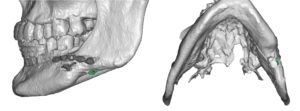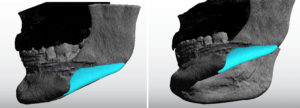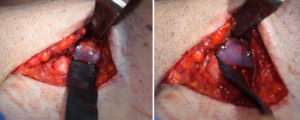Background: Fractures of the lower jaw is the second most common facial fracture other than the nose. Amongst these traumatic jaw bone injuries, fractures through the jaw angles is the most frequently location along the course of the bone. They can be difficult to surgically repair due to both surgical access as well as the biomechanics forces to which it is exposed
Open reduction and internal fixation of jaw angle fractures focuses on realignment of the bone along the inferior border after the occlusion is re-established and stabilized. Before plate and screw fixation, the use of interosseous wires was the only fixation method available which was less rigid and is associated with higher rates of misalignment.
Besides misalignment of the bite the most common jaw angle fracture repair deformity is notching or irregularities along the jawline across the fracture line. This is usually the result of the proximal bone segment being rotated upward due to the full of the pterygomasseteric sling muscles.



Contour deformities along the jawline can be most effectively reconstructed with a custom implant approach made from the patient’s 3D CT scan. In this case access for placement was done through an existing neck scar from prior surgery. In most other cases the implant’s placement would have been done through an intraoral approach.
Highlights:
1) Jaw fractures often result in jawline deformities due to either how the bones are aligned during surgical repair or loss of actual bone structure.
2) Bone defects that create contour deformities along the inferior border can be reconstructed with a custom jawline implant.
3) Contrary to popular perception even small jaw defects are best treated by 3D designed implants from a CT scan.
Dr. Barry Eppley
Indianapolis, Indiana



